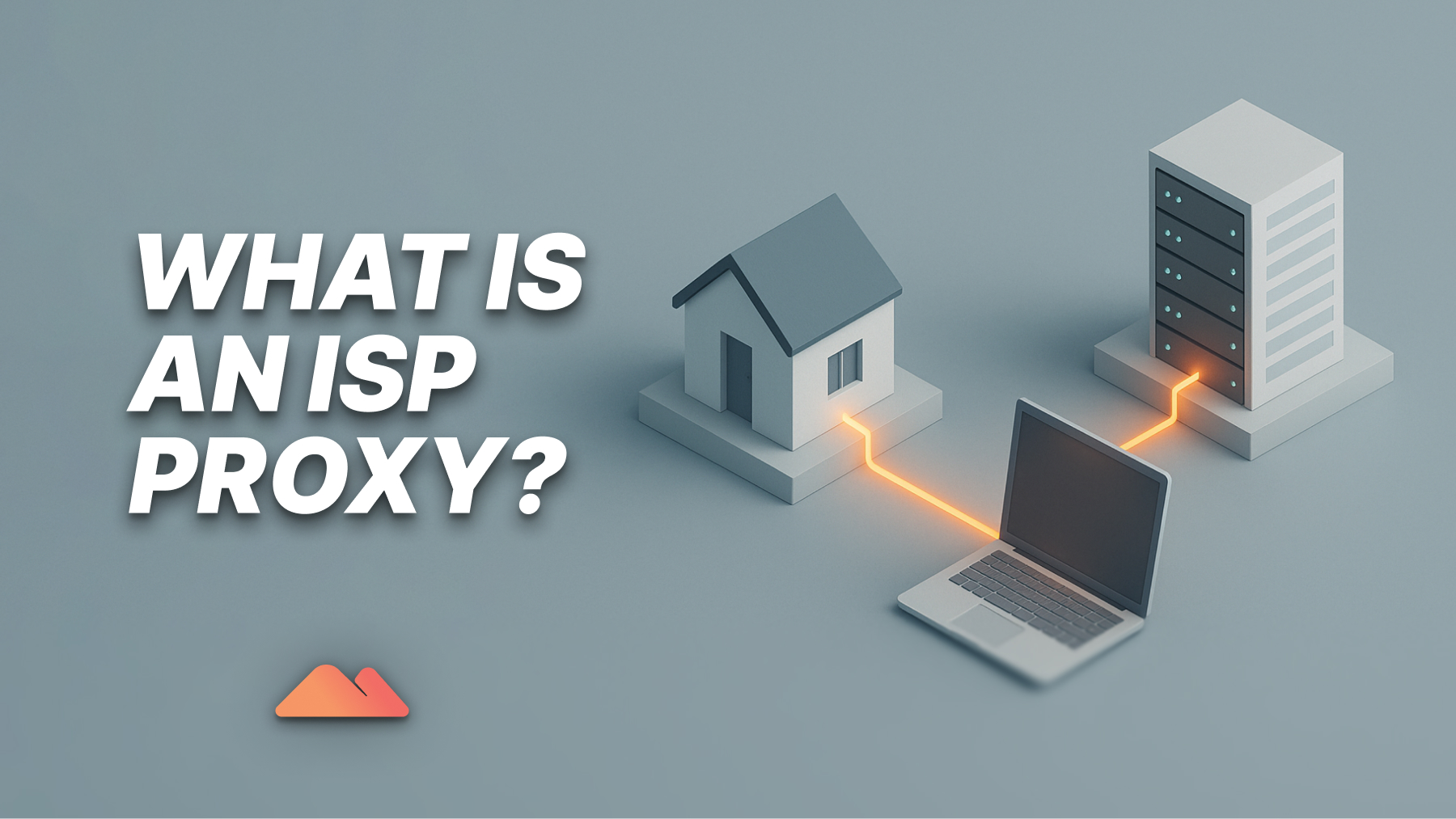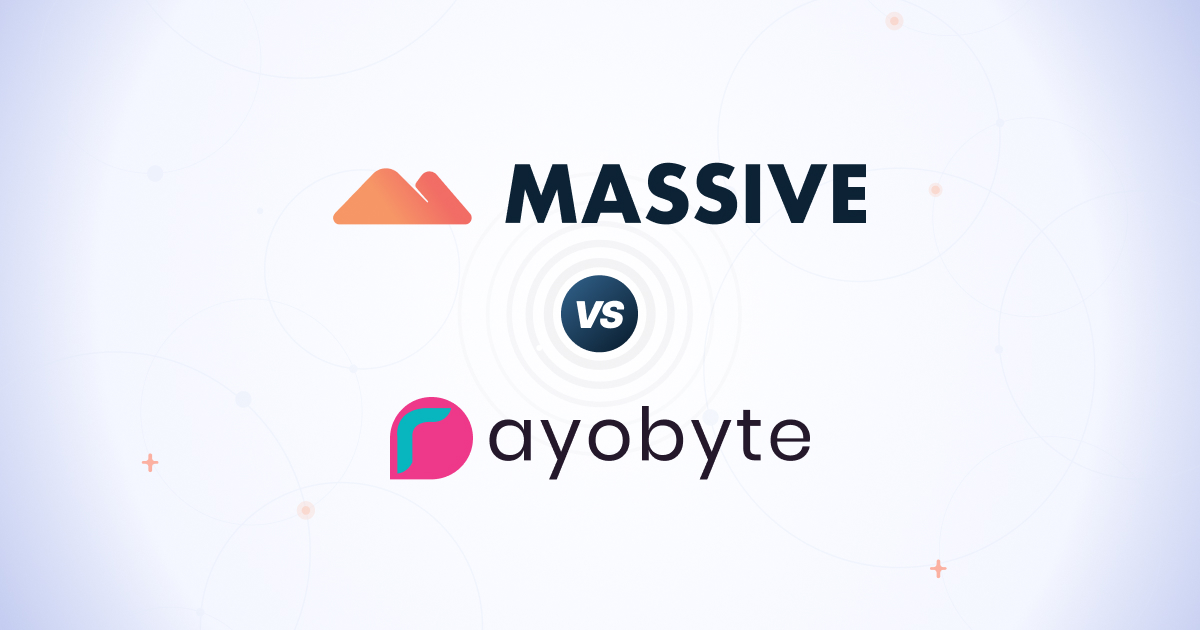Un proxy ISP, también denominado proxy residencial estático, es una dirección IP que combina lo mejor de ambos mundos: está registrada en un proveedor de servicios de Internet (ISP) real, como un proxy residencial, pero alojada en un servidor de un centro de datos. Esto hace que sea más rápido y estable que la mayoría de los proxies residenciales rotativos, a la vez que parece igual de legítimo para segmentar sitios web.
Ya sea que administre varias cuentas de redes sociales, realice estudios de mercado o automatice las tareas de comercio electrónico, comprender los proxies de los ISP puede afectar significativamente su tasa de éxito y eficiencia operativa. En esta guía completa, aprenderás exactamente cómo funcionan los proxies de los ISP, cuándo usarlos, sus principales ventajas y desventajas, las consideraciones de precio y cómo se comparan con otros tipos de proxy. Para ver una comparación detallada con los proxies residenciales, consulta nuestra ISP frente a proxies residenciales guía.
¿Cómo funcionan los proxies de ISP? Análisis técnico profundo
La infraestructura detrás de los proxies de ISP
Un proxy de ISP funciona mediante una configuración de infraestructura sofisticada que une la legitimidad residencial con el rendimiento del centro de datos:
Proceso de registro de direcciones IP: Las direcciones IP las asigna un ISP real a través de canales legítimos, que suelen incluir:
- Asociaciones directas entre proveedores de proxy e ISP
- Acuerdos de arrendamiento masivo de direcciones IP
- Registro adecuado en los registros regionales de Internet (RIR)
- Cumplimiento de las políticas de asignación de ISP
Alojamiento de centros de datos: En lugar de enrutarse a través del dispositivo de una persona real, las IP se encuentran en servidores de centros de datos de alto rendimiento que incluyen:
- Infraestructura de red de nivel empresarial
- Conectividad redundante con varios operadores
- Garantías de disponibilidad de más del 99,9%
- Administración y supervisión profesionales de servidores
Arquitectura de subred: Los proxies de ISP suelen organizarse en subredes (rangos de IP) que:
- Contienen entre 16 y 256 direcciones IP del mismo ISP
- Están concentrados geográficamente en ciudades específicas
- Mantenga características de enrutamiento y rendimiento consistentes
- Permiten la asignación y administración eficientes de los recursos
Esta configuración significa que obtiene el nivel de confianza de una IP residencial, además de la velocidad y confiabilidad de un servidor dedicado. Como son «estáticas», su IP no cambia durante una sesión, lo que las hace ideales para tareas que requieren identidades consistentes durante períodos prolongados.
En qué se diferencian los proxies ISP de los proxies tradicionales
Autenticación y legitimidad: A diferencia de los proxies de centros de datos que son fácilmente identificables por su ASN (número de sistema autónomo), los proxies de ISP llevan la huella digital de los ISP residenciales legítimos. Los sitios web los ven como auténticas conexiones domésticas a Internet, que incluyen:
- Registro de ASN residencial
- Registros DNS inversos adecuados
- Coherencia geográfica con las áreas de servicio de los ISP
- Patrones de tráfico naturales y firmas de uso
Características de rendimiento: El alojamiento del centro de datos proporciona métricas de rendimiento consistentes:
- Latencia: 10-50 ms (frente a 100-500 ms para uso residencial)
- Ancho de banda: más de 100 Mbps+ (frente a 1 a 10 Mbps para uso residencial)
- Fiabilidad: 99,9% de tiempo de actividad (frente al 85-95% en el sector residencial)
- Tiempo de respuesta: <200 ms de promedio (frente a 500-2000 ms para uso residencial)
Ventajas de los proxies ISP: por qué son superiores para muchos casos de uso
1. Mayor confianza y legitimidad
Reputación IP superior: Los proxies de ISP mantienen puntuaciones de reputación IP limpias porque:
- Están registrados en ISP legítimos, no en centros de datos
- Tasas de abuso histórico más bajas en comparación con las IP de los centros de datos
- Asociación geográfica y de ISP uniforme
- Patrones naturales de distribución del tráfico
Tasas de detección reducidas: Los sitios web de destino tienen dificultades para identificar los proxies de ISP porque:
- Carecen de las firmas obvias de los centros de datos
- Sin agrupamiento en clústeres en los rangos de IP de proxy conocidos
- Registros DNS inversos de tipo residencial
- Coherente con los patrones de comportamiento normales de los usuarios
2. Ventajas de rendimiento y confiabilidad
Rendimiento constante a alta velocidad: A diferencia de los proxies residenciales que dependen de las conexiones de los usuarios finales:
- Asignación de ancho de banda garantizada
- Infraestructura de red profesional
- Opciones de conectividad redundante
- Variaciones mínimas de latencia
Estabilidad de la sesión: Las direcciones IP estáticas proporcionan:
- Identidad uniforme a lo largo de las sesiones
- Sin cambios de IP a mitad de sesión
- Persistencia de conexión confiable
- Métricas de rendimiento previsibles
3. Beneficios operativos
Tasas de CAPTCHA más bajas: Con un uso adecuado, las IP residenciales estáticas generan menos desafíos de seguridad:
- Reputación de IP uniforme a lo largo del tiempo
- Reducción de la detección de comportamientos similares a los de los bots
- Menor frecuencia de los controles de seguridad
- Tasas de éxito mejoradas para tareas automatizadas
Flexibilidad geográfica: Los proveedores de proxy ISP de calidad ofrecen:
- Varias ciudades dentro de los países
- Diversas asociaciones de ISP
- Posicionamiento geográfico específico
- Cumplimiento de las normativas locales
4. Rentabilidad para casos de uso específicos
Óptimo para tareas de sesión prolongada: Si bien son más caros por IP, los proxies de ISP ofrecen una mejor relación calidad-precio para:
- Sesiones de navegación ampliadas
- Tareas de administración de cuentas
- Procesos complejos de varios pasos
- Aplicaciones que requieren una identidad coherente
Desventajas y limitaciones de los proxies ISP
1. Mayores costos y requisitos de inversión
Estructura de precios premium: Los proxies de ISP tienen precios más altos debido a:
- Disponibilidad limitada de rangos de IP residenciales
- Mayores costos de infraestructura para los proveedores
- Requisitos exclusivos de asociación con ISP
- Gastos de hospedaje de nivel profesional
Rangos de precios típicos:
- Proxies ISP básicos: entre 3 y 8 USD por IP al mes
- Segmentación geográfica premium: entre 8 y 15 dólares por IP al mes
- Soluciones empresariales: más de 15 a 30 USD por IP al mes
- Subredes personalizadas: más de 50 a 200 USD por subred al mes
2. Tamaños de piscina y escalabilidad limitados
Piscinas más pequeñas disponibles: En comparación con las redes proxy residenciales:
- Miles frente a millones de IP disponibles
- Cobertura geográfica limitada
- Asociaciones de ISP restringidas
- Limitaciones de capacidad durante los picos de demanda
Desafíos de escalabilidad: Para operaciones a gran escala:
- Opciones de rotación de IP insuficientes
- Mayores costos por solicitud
- Capacidad limitada de sesiones simultáneas
- Obstáculos en la asignación de recursos
3. Posibles restricciones a nivel de subred
Riesgo de responsabilidad colectiva: Si varios usuarios abusan de la misma subred proxy del ISP:
- Es posible que se bloqueen rangos de IP completos
- El daño a la reputación afecta a todos los usuarios
- El tiempo de recuperación se puede extender
- Opciones alternativas limitadas dentro de la misma ubicación
Estrategias de mitigación:
- Elija proveedores con políticas de uso estrictas
- Supervise la reputación de IP con regularidad
- Implemente estrategias de rotación
- Mantener varias opciones de subred
Mejores casos de uso para proxies de ISP: aplicaciones detalladas
1. Gestión de redes sociales y marketing
Operaciones con múltiples cuentas: Los proxies de ISP son excelentes para la administración de redes sociales porque:
- La identidad IP uniforme evita la vinculación de cuentas
- La apariencia residencial reduce el riesgo de suspensión
- Las conexiones estables permiten la interacción en tiempo real
- Segmentación geográfica para audiencias locales
Mejores prácticas de implementación:
- Use una IP por cuenta de manera consistente
- Haga coincidir la ubicación IP con la ubicación supuesta de la cuenta
- Implemente patrones de uso naturales
- Supervise las restricciones específicas de la plataforma
Métricas de éxito:
- Tasas de suspensión de cuentas: < 2% (frente al 15-30% con el centro de datos)
- Mejoras en la tasa de participación: 25-40%
- Éxito en la entrega de contenido: tasas de finalización superiores al 95%
- Precisión de segmentación geográfica: > 98%
2. Comercio electrónico y monitoreo de precios
Inteligencia competitiva: Los proxies de ISP proporcionan un acceso fiable para:
- Comparación de precios en múltiples plataformas
- Monitorización del inventario para envíos directos
- Investigación de mercado sin detección
- Análisis de variación geográfica de precios
Automatización de compras y pagos: Crítico para éxito del comercio electrónico:
- Identidad uniforme durante todo el proceso de compra
- Reducción del abandono del carrito debido a cambios de IP
- Menor activación de la detección de fraudes
- Tasas de éxito en el procesamiento de pagos mejoradas
Ejemplo de estudio de caso: Un minorista de calzado usó proxies de ISP para monitorear los precios de la competencia en 15 países. Resultados:
- Reducción del 40% en las solicitudes bloqueadas
- Recopilación de datos un 60% más rápida
- Mejora del 25% en la precisión de los precios
- Ingresos adicionales de 2,3 millones de dólares gracias a la optimización de precios
3. Sneaker Copping y lanzamientos de edición limitada
Automatización de alto riesgo: Para lanzamientos limitados de productos:
- IP uniforme durante todo el proceso de pago
- Reducción de la probabilidad de detección de bots
- Procesamiento más rápido que los proxies residenciales
- Posicionamiento geográfico para lanzamientos específicos
Requisitos técnicos:
- Tiempos de respuesta inferiores a 200 ms
- Tiempo de actividad del 99,9% durante los períodos críticos
- Asignación de IP dedicada
- Medidas antidetección avanzadas
Factores de éxito:
- Periodo de calentamiento de IP antes de los lanzamientos
- Configuración adecuada de usuario-agente y encabezado
- Simulación del comportamiento de navegación natural
- Estrategias coordinadas de múltiples IP
4. Verificación de anuncios e investigación de mercado
Monitoreo de campañas: Los proxies de ISP permiten una verificación precisa de los anuncios:
- Verificación de visualización de anuncios segmentados geográficamente
- Análisis de campañas de la competencia
- Detección y prevención del fraude por clic
- Supervisión de la seguridad de la marca
Aplicaciones de investigación:
- Análisis del comportamiento del consumidor
- Identificación de tendencias de mercado
- Pruebas de contenido localizado
- Verificación del ranking SEO
Ventajas operativas:
- Metodología coherente de recopilación de datos
- Reducción del sesgo muestral
- Precisión geográfica mejorada
- Menor costo por punto de datos
5. Extracción web y recopilación de datos
Proyectos de raspado específicos: Los proxies de ISP son óptimos para:
- Recopilación de datos a mediana escala (entre 10 000 y 1 millones de solicitudes al día)
- Operaciones de raspado centradas en la calidad
- Extracción de datos basada en cuentas
- Tareas de supervisión de larga duración
Ventajas técnicas:
- Reputación de IP uniforme
- Límite de tarifa reducida
- Tasas de encuentro de CAPTCHA más bajas
- Persistencia de conexión estable
Métricas de rendimiento:
- Tasa de éxito: 85-95% (frente al 70-85% del centro de datos)
- Tiempo medio de respuesta: <300 ms
- Bloques por cada 1000 solicitudes: <5
- Persistencia de la sesión: más del 99%
Criterios de comparación y selección de proveedores de proxy ISP
Análisis de proveedores de primer nivel
Al elegir un proveedor de proxy ISP, es crucial evaluar tanto las capacidades técnicas como la confiabilidad empresarial. En Servicios de proxy ISP de alto rendimiento de Massive, hemos optimizado nuestra infraestructura para ofrecer un rendimiento de nivel empresarial con legitimidad de nivel residencial, lo que nos convierte en una opción confiable para las empresas que requieren soluciones de proxy consistentes y de alto rendimiento.
Marco de evaluación de proveedores: Al seleccionar un proveedor de proxy ISP, tenga en cuenta lo siguiente:
Capacidades técnicas:
- Tamaño del pool de IP y cobertura geográfica
- Fiabilidad y tiempo de actividad de la infraestructura
- Velocidad de conexión y latencia
- Funcionalidad de la API y opciones de integración
Precio y valor:
- Coste por IP y precios basados en el uso
- Requisitos mínimos de compromiso
- Opciones de escalabilidad y descuentos por volumen
- Tarifas adicionales y costos ocultos
Soporte y confiabilidad:
- Calidad y disponibilidad del soporte técnico
- Recursos de documentación e integración
- Consideraciones legales y de cumplimiento
- Comunidad de usuarios y comentarios
Tabla comparativa de precios
<table class="GeneratedTable">
<thead>
<tr>
<th>Nivel de proveedor</th>
<th>Rango de precios</th>
<th>Tamaño de la piscina</th>
<th>Características principales</th>
</tr>
</thead>
<tbody>
<tr>
<td>Presupuesto</td>
<td>entre 3 y 6 USD por IP al mes</td>
<td>IP de 1 000 a 5 000</td>
<td>Segmentación geográfica básica</td>
</tr>
<tr>
<td>Gama media</td>
<td>entre 6 y 12 USD por IP al mes</td>
<td>IP de 5000 a 20 000</td>
<td>Funciones avanzadas</td>
</tr>
<tr>
<td>Premium</td>
<td>12 a 25 USD/IP/mes</td>
<td>Más de 20 000 IP</td>
<td>Soporte empresarial</td>
</tr>
<tr>
<td>Empresarial</td>
<td>25$ o más /IP/mes</td>
<td>Personalizado</td>
<td>Infraestructura dedicada</td>
</tr>
</tbody>
</table>
Lista de verificación de criterios de selección
Requisitos esenciales:
- Garantía mínima de disponibilidad del 99%
- Cobertura geográfica en los mercados objetivo
- Atención al cliente receptiva
- Estructura de precios transparente
- Cumplimiento de las normativas locales
Funciones avanzadas:
- Acceso a la API para la automatización
- Supervisión del estado de la IP en tiempo real
- Asignación de subred personalizada
- Opciones de autenticación avanzadas
- Análisis e informes de uso
Mejores prácticas y estrategias de optimización
1. Rotación y gestión de IP
Patrones de rotación estratégica:
- Rotación basada en el tiempo para diferentes zonas horarias
- Asignación de IP para tareas específicas
- Rotación geográfica para campañas globales
- Equilibrio de carga en varias IP
Supervisión del estado de la propiedad intelectual:
- Controles periódicos de reputación
- Seguimiento de métricas de rendimiento
- Procedimientos de reemplazo proactivos
- Sistemas de conmutación por error automatizados
2. Configuración y configuración
Parámetros de configuración óptimos:
Tiempo de espera de conexión: 30 segundos
Tiempo de espera de solicitud: 60 segundos
Reintentos: 3
Conexiones simultáneas: 5-10 por IP
Límite de velocidad: 1-2 solicitudes por segundo
Administración de encabezados y agentes de usuario:
- Cadenas de usuario-agente coherentes
- Configuración adecuada de la cabecera
- Coincidencia geográfica de encabezados
- Coherencia de huellas digitales del navegador
3. Optimización del rendimiento
Agrupación de conexiones:
- Mantener conexiones persistentes
- Implemente la reutilización de conexiones
- Supervisa el estado de la conexión
- Optimice los ciclos de vida de las conexiones
Optimización de solicitudes:
- Implemente los retrasos adecuados entre las solicitudes
- Utilice métodos de análisis de datos eficientes
- Minimice el tamaño de la carga útil
- Optimice los patrones de solicitud
4. Seguridad y cumplimiento
Protección de datos:
- Implemente el cifrado adecuado
- Administración segura de credenciales
- Auditorías de seguridad periódicas
- Cumplimiento de las leyes de protección de datos
Pautas de uso ético:
- Respete los términos de servicio del sitio web
- Implemente límites de tarifas razonables
- Evite una carga excesiva del servidor
- Mantenga políticas de uso transparentes
Solución de problemas comunes
1. Problemas de conexión
Síntoma: Tiempos de espera de conexión frecuentes
Causas:
- Congestión de la red
- Problemas de enrutamiento de ISP
- Restricciones de firewall
- Sobrecarga del servidor proxy
Soluciones:
- Implementar la lógica de reintento de conexión
- Utilice varios puntos finales de proxy
- Configurar los tiempos de espera adecuados
- Supervise la latencia de red
2. Problemas de rendimiento
Síntoma: Tiempos de respuesta lentos
Causas:
- Distancia geográfica desde el objetivo
- Sobrecarga del servidor proxy
- Congestión de la red
- Patrones de solicitud ineficientes
Soluciones:
- Elija proxies geográficamente más cercanos
- Optimizar la frecuencia de las solicitudes
- Implementar la agrupación de conexiones
- Utilice herramientas de supervisión del rendimiento
3. Restricciones de acceso
Síntoma: Acceso bloqueado o limitado
Causas:
- Problemas de reputación de IP
- Disparadores que limitan la velocidad
- Restricciones geográficas
- Detección mediante sistemas antibots
Soluciones:
- Rotar direcciones IP
- Implemente patrones de uso realistas
- Utilice los encabezados y los agentes de usuario adecuados
- Supervise los patrones de detección
4. Problemas de autenticación
Síntoma: Fallos de autenticación
Causas:
- Credenciales incorrectas
- Restricciones de lista blanca de IP
- Problemas de tiempo de espera de sesión
- Limitación de velocidad de API
Soluciones:
- Verificar las credenciales de autenticación
- Implemente una gestión adecuada de las sesiones
- Usa sesiones fijas cuando sea necesario
- Supervise las tasas de éxito de autenticación
Estrategias de implementación avanzadas
1. Arquitecturas de proxy múltiple
Estrategias de equilibrio de carga:
- Distribución por turnos
- Equilibrio de carga ponderada
- Equilibrio de carga geográfico
- Enrutamiento basado en el rendimiento
Sistemas de conmutación por error:
- Conmutación automática de proxy
- Monitorización de controles de estado
- Degradación elegante
- Procedimientos de respaldo de emergencia
2. Automatización y escalado
Integración de API:
- Utilización de la API RESTful
- Implementaciones de webhook
- Monitorización en tiempo real
- Aprovisionamiento automatizado
Estrategias de escalado:
- Enfoques de escalado horizontal
- Asignación dinámica de recursos
- Escalado automático según la demanda
- Técnicas de optimización de costos
3. Monitoreo y análisis
Métricas de rendimiento:
- Monitorización del tiempo de respuesta
- Seguimiento de la tasa de éxito
- Análisis de la tasa de errores
- Métricas de utilización de recursos
Inteligencia empresarial:
- Métodos de cálculo del ROI
- Análisis coste-beneficio
- Evaluación comparativa del rendimiento
- Análisis y previsión de tendencias
Tendencias y desarrollos futuros
1. Evolución tecnológica
Tecnologías emergentes:
- Impacto de la adopción de IPv6
- Selección de proxy basada en IA
- Optimización del aprendizaje automático
- Redes proxy basadas en blockchain
Desarrollos de la industria:
- Mayor regulación y cumplimiento
- Medidas de seguridad mejoradas
- Estándares de rendimiento mejorados
- Creciente demanda del mercado
2. Predicciones de mercado
Proyecciones de crecimiento:
- Expansión del tamaño del mercado: 15-20% anual
- Mayor adopción empresarial
- Oportunidades de expansión geográfica
- Tendencias de integración tecnológica
Desafíos y oportunidades:
- Requisitos de cumplimiento normativo
- Preocupaciones de seguridad y privacidad
- Necesidades de optimización del rendimiento
- Presiones de optimización de costos
Conclusión
Los proxies de ISP representan un poderoso punto medio entre la legitimidad de los proxies residenciales y el rendimiento de los proxies de centros de datos. Su combinación única de direcciones IP residenciales alojadas en la infraestructura del centro de datos los hace ideales para las empresas que requieren soluciones de proxy consistentes y de alto rendimiento.
La clave del éxito con los proxies de ISP radica en comprender sus puntos fuertes y limitaciones, elegir el proveedor adecuado para sus necesidades específicas e implementar las estrategias de optimización adecuadas. Si bien pueden costar más que las alternativas, la mejora de las tasas de éxito, el rendimiento constante y la reducción de la complejidad operativa a menudo justifican la inversión.
A medida que la industria de los proxies siga evolucionando, es probable que los proxies de los ISP sean aún más importantes para las empresas que requieren soluciones de proxy confiables y de alto rendimiento. Si sigue las mejores prácticas y estrategias descritas en esta guía, puede maximizar el valor de su inversión en servidores proxy de un ISP y alcanzar sus objetivos empresariales de manera más eficaz.
Ya sea que administre cuentas de redes sociales, realice estudios de mercado o automatice las operaciones de comercio electrónico, los proxies de los ISP brindan la confiabilidad y el rendimiento necesarios para tener éxito en el competitivo panorama digital actual. Tómese el tiempo necesario para evaluar sus requisitos específicos, elegir el proveedor adecuado e implementar las estrategias de optimización adecuadas para aprovechar al máximo su inversión en servicios de proxy como ISP.

Soy el cofundador y director ejecutivo de Massive. Además de trabajar en nuevas empresas, soy músico, atleta, mentor, anfitrión de eventos y voluntario.
Opiniones de clientes
Pregunta frecuente
¿Cuál es la diferencia entre los proxies ISP y los proxies residenciales?
+
Los proxies de ISP utilizan direcciones IP residenciales alojadas en servidores de centros de datos, mientras proxies residenciales ruta a través de dispositivos de usuario reales. Los proxies de ISP ofrecen un mejor rendimiento y confiabilidad, mientras que los proxies residenciales brindan grupos de IP más grandes y una cobertura geográfica más diversa. Para obtener una comparación detallada, lee nuestra Guía de ISP frente a proxies residenciales.
¿Es legal usar proxies de ISP?
+
Sí, los proxies de los ISP son legales cuando se utilizan con fines legítimos, como la investigación de mercado, la supervisión de precios y la verificación de anuncios. Sin embargo, los usuarios deben cumplir con las condiciones de servicio del sitio web y las leyes aplicables en su jurisdicción.
¿Cuántos proxies ISP necesito para mi proyecto?
+
El número depende de sus requisitos específicos:
- Gestión de redes sociales: 1 IP por cuenta
- Extracción web: de 1 a 10 direcciones IP por cada 1000 solicitudes/hora
- Supervisión del comercio electrónico: 5-20 IP por sitio web de destino
- Verificación de anuncios: 10 a 50 direcciones IP por campaña
¿Cuál es la vida útil típica de una IP de proxy de un ISP?
+
Las IP de los proxies de los ISP suelen permanecer activas durante 1 a 12 meses, según los patrones de uso y las políticas del proveedor. Las IP bien mantenidas pueden durar más tiempo con una rotación adecuada y un uso razonable.
¿Puedo usar proxies de ISP para los servicios de streaming?
+
Si bien es técnicamente posible, la mayoría de los servicios de streaming bloquean activamente el uso del proxy independientemente del tipo. Los proxies de los ISP pueden funcionar temporalmente, pero no se recomiendan para las aplicaciones de streaming.
¿Cómo compruebo si el proxy de mi ISP funciona correctamente?
+
Puedes probar el proxy de tu ISP de la siguiente manera:
- Comprobando tu dirección IP en whatismyipaddress.com
- Verificar que la ubicación geográfica coincida con las expectativas
- Probar la accesibilidad del sitio web
- Supervisión de los tiempos de respuesta y las tasas de éxito
¿Cuál es el ROI de usar proxies de ISP en comparación con las alternativas gratuitas?
+
Los proxies ISP suelen ofrecer tasas de éxito entre 3 y 5 veces mejores y un rendimiento entre 2 y 3 veces más rápido en comparación con los proxies gratuitos, lo que se traduce en una mayor productividad y menores costos operativos a pesar de una mayor inversión inicial.
¿Cómo escalo el uso de proxy de mi ISP a medida que crece mi empresa?
+
Las estrategias de escalamiento incluyen:
- Negociación de descuentos por volumen con los proveedores
- Implementación de sistemas de administración de proxy automatizados
- Uso del equilibrio de carga en varios proveedores
- Optimización de los patrones de uso para reducir los costos







